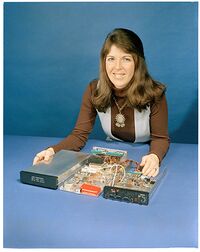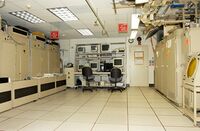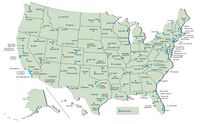Milestones:Development of the Mode S Next-Generation ATC Radar Beacon System
This is a temporary page. The final version of this page can be found on the Engineering and Technology History Wiki
Title
Mode S Air Traffic Control Radar Beacon System, 1969-1995
Citation
In 1969, MIT Lincoln Laboratory began developing the Mode S selective secondary surveillance radar beacon system to enable safe air traffic control in busy, spectrum-congested airspace. This technology made more efficient use of the radio spectrum than previous systems. By 1995, the Mode S techniques and transmission codes became the worldwide standard for air traffic control radars.
Street address(es) and GPS coordinates of the Milestone Plaque Sites
244 Wood Street, Lexington, MA 02421 (coordinates in decimal degrees: 42.459061, -71.266997), 244 Wood Street, Lexington, MA 02421 (coordinates in decimal degrees: 42.459061, -71.266997)
Details of the physical location of the plaque
Main entrance area, in a display case. Lobby is at the base of the hill where the Mode S prototype was installed
How the intended plaque site is protected/secured
MIT Lincoln Laboratory is a secure facility
Historical significance of the work
The original Air Traffic Control Radar Beacon System (ATCRBS) was in widespread use across the Air Traffic Control system. However, by the late 1960s, the rapid growth in aviation necessitated the development of a spectrum-efficient technical solution to accommodate reliable aircraft surveillance in regions with high traffic densities. The Mode S design introduced the selective interrogation of addressable transponders, a datalink between the cockpit and ground systems, and improved azimuth, altitude, and range resolution. An expansive, backward compatible design and prototype was developed for both the radar system and the avionics units. This work was performed at MIT Lincoln Laboratory and demonstrated at the Mode S Experimental System in Lexington Massachusetts. Eventually this design was adopted as an international standard and deployed at the major airports throughout the world.
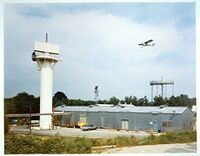
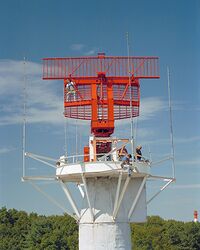
Features that set this work apart from similar achievements
<h3> The MIT Lincoln Laboratory design included the following capabilities:</h3> <br> <b>• Monopulse azimuth measurements, using sum and difference beams, enabling:</b> <ul>
<li>Lower interrogation rates to reduce reply channel loading and transponder occupancy</li> <li>Improved reply detection using monopulse for correlation</li> <li>Improved azimuth accuracy</li> <li>Monopulse to be applied to Mode S and ATCRBS surveillance</li>
</ul> <br> <b>• Mode S to operate transparently on 1030, 1090 MHz</b> <ul>
<li>Mode S interrogations (to Mode S transponders) are not detected by ATCRBS transponders.</li> <li>Mode S transponders reply to ATCRBS interrogations from ATCRBS interrogators but not from Mode S interrogators.</li>
</ul> <br> <b>• Discrete addressing of Mode S transponders, including</b> <ul>
<li>An acquisition method for new targets, followed by addressed interrogations</li> <li>Efficient scheduling of discrete interrogations, and immediate retries if necessary</li> <li>Parity protection and error correction for Mode S signals</li> <li>Integral datalink, with 56 or 112 bits per message</li> <li>Pulse position modulation of the Mode S reply to provide the same number of pulses for monopulse, independent of the message content</li>
</ul> <br> <b>• Top and bottom transponder antennas to mitigate banking fades</b>
Significant references
Vincent A. Orlando., <i>“The Mode S Radar Beacon System”</i>, MIT Lincoln Laboratory Journal, Volume 2, Number 3, 1989. Media:Mode_S_Radar_Beacon_System_Lincoln_Journal_Vol_2_Number_3.pdf
Edward M. Hofstetter and Darrol F. Delong, Jr., <i>“Detection and Parameter Estimation in an Amplitude-Comparison Monopulse Radar”</i>, IEEE Transactions on Information Theory, Vol. IT-15, No. 1, January 1969. Media:Detection and Parameter Estimation in an Amplitude-Comparison Monopulse Radar.pdf
D. A. Shnidman, <i>“A Comparison of Immunity to Garbling for Three Candidate Modulation Schemes for DABS”</i>, MIT Lincoln Laboratory, Project Report ATC-12, 14 August 1972, FAA-RD-72-84. Media:Shnidman_1972_ATC-12_WW-15318.pdf
P. R. Drouilhet, <i>“Provisional Signal Formats for the Discrete Address Beacon System”</i>, MIT Lincoln Laboratory Project Report ATC-30.1, 25 April 1974, FAA-RD-74-62. Media:Drouilhet_1974_ATC-30i_WW-15318.pdf
J. -C. Sureau, <i>“A Summary of DABS Antenna Studies”</i>, MIT Lincoln Laboratory, Project Report ATC-53, 3 February 1976, FAA-RD-75-112. Media:Summary of DABS antenna studies-1.pdf
T. J. Goblick, <i>"DABS Modulation and Coding Design"</i>, MIT Lincoln Laboratory Project Report ATC-52, 12 March 1976, FAA-RD-75-93. Media:Goblick_1976_ATC-52_WW-15318.pdf
R. J. McAuley and V. Vitto, <i>“A Simulation of the DABS Sensor for Evaluating Reply Processor Performance”</i>, MIT Lincoln Laboratory, Project Report ATC-28, 16 September 1974, FAA-RD-74-123. Media:Mcaulay_1974_ATC-28_WW-15318.pdf
International Civil Aviation Organization, <i>“International Standards and Recommended Practices, Annex 10 to the Convention on Civil Aviation, Aeronautical Telecommunications, Volume IV Surveillance and Collision Avoidance Systems”</i>, Fifth Edition, Annex 10, Volume 4, July 2014. Media:International Standards and Recommended Practices, Surveillance and Collision Avoidance Systems, Annex 10, Volume 4.pdf <br> <br> <br> <br> <br> <br> <br> <br> <br>
Supporting materials
<br> <br> (1) Support letter from <ul> <li>Dr. Eric Evans, the Director of MIT Lincoln Laboratory: </ul> Media:Support_Letter_IEEE_Milestone_MIT_LL_Development_of_the_Mode_S_Next_Generation_ATC_Radar_Beacon_System_signed.pdf</li> <br> <br> (2) Support letter from <ul> <li>2022 IEEE Boston Section Chair, Denise Griffin, 44griffin@comcast.net</li> <li>IEEE Boston Section Milestone Coordinator, gilcooke@ieee.org</li> </ul> Media: Section_Chair_Support_Letter_IEEE_Milestone_MIT_LL_Development_of_the_Mode_S_Next_Generation_ATC_Radar_Beacon_System.pdf <br> <br>
